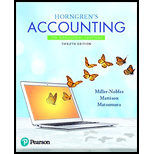Problem 1QC: The detailed record of the changes in a particular asset, liability, or owner’s equity is called... Problem 2QC: Which of the following accounts is a liability? Learning Objedve 1 a. Accounts Receivable b. Service... Problem 3QC: The left side of an account is used to record which of the following? Learning Objective 2 a. Debit... Problem 4QC: Which of the following statements is correct? Learning Objective 2 a. Prepaid Expenses are decreased... Problem 5QC: Your business purchased office supplies of $2,500 on account. The journal entry to record this... Problem 6QC: Sedlor Properties puchased office supplies on account for $800. Which journal entry : records the... Problem 7QC: Posting a $2,500 purchase of office supplies on account appears as follows: Lerning Objective 3 Problem 8QC: Pixel Copies recorded a cash collection on account by debiting Cash and creditng Accounts Payable.... Problem 9QC: Which sequence correctly summarizes the accounting process? Learning Obectves 3,4 a. Journalize... Problem 10QC: Nathvile Laundry reported assets of $800 and equity of $480. What is Nathvile’s debt ratio? Learning... Problem 1RQ: Identify the three categones of the accounting equation, and list at least four accounts associated... Problem 2RQ: What is the purpose of the chart of accounts? Explain the numbering typically associated with the... Problem 3RQ: What does a ledger show? What’s the difference between a ledger and the chart of accounts? Problem 4RQ: Accounng uses a double-entry system. Explain what this sentence means. Problem 5RQ: What is T-account? On which side is the debit? On which side is the credit? Where does the account... Problem 6RQ Problem 7RQ Problem 8RQ: Identify which types of accounts have a normal debit balance and which types of accounts have a... Problem 9RQ: What are source documents? Provide examples of source documents that a business might use. Problem 10RQ Problem 11RQ: Explain the five steps in journalizing and posting transactions. Problem 12RQ: What are the four parts of a journal entry? Problem 13RQ: What is involved in the posting process? Problem 14RQ: What is the purpose of the trial balance? Problem 15RQ: What is the differnce between the trial balance and the balance sheet? Problem 16RQ: If total debits equal total credits on the trial balance, is the trial balance error-free? Explain... Problem 17RQ: What is the calculation for the debt ratio? Explain what the debt ratio evaluates. Problem S2.1SE: Identifying accounts Learning Objective 1 Consider the following accounts and identify each account... Problem S2.2SE: Identifying increases and decreases in accounts Learning Objective 2 For each account, identify... Problem S2.3SE: Identifying normal balances Learning Objective 2 For each account, identify whether the normal... Problem S2.4SE Problem S2.5SE: Journalizing transactions Learning Objective 3 John Daniel opened a medical practice in Sacramento,... Problem S2.6SE: S2-6 Journalizing transactions
Learning Objective 3
Harper Sales Consultants completed the... Problem S2.7SE: Journalizing transactions and posting to T-accounts Learning Objective 3 Roland Foster Optical... Problem S2.8SE Problem S2.9SE Problem E2.10E: Using accounting vocabulary Learning Objectives 1, 2, 3, 4 Match the accounting terms with the... Problem E2.11E: Creating a chart of accounts Learning Objective 1 Raymond Autobody Shop has the folowing accounts:... Problem E2.12E: Identifying accounts, increases in accounts, and normal balances Learnmg Objective 1, 2 a. interest... Problem E2.13E: Identifying increases and decreases in accounts and normal balances Learning Objective 2 Insert the... Problem E2.14E: Identifying source documents Learning Objective 3 For each trasaction, identy a possible source... Problem E2.15E: Analyzing and journalizing transactions Learing Objective 3 As the manager of Margarita Mexican... Problem E2.16E: Analyzing and journalizing transactions Leaning Objective 3 Journalize the transactions of Lawrence... Problem E2.17E: Posting journal entries to T-accounts Learning Obgective 3 3. Cash Balance $18,090 Requirements 1.... Problem E2.18E: Analyzing and journalizing transactions Learning Objective 3 Journalize the transactions of Wilke... Problem E2.19E: Posting journal entries to four-column accounts Learning Objective 3 2. 2. Cash Balance $52,050... Problem E2.20E: Analyzing transactions from T-accounts Learning Objective 3 The first nine transactions of... Problem E2.21E: Journalizing transactions from T-accounts Learning Objective 3 In December 2018, the first five... Problem E2.22E: Preparing a trial balance Learning Objective 4 Tota Debits $191,800 The accounts of Anderson Moving... Problem E2.23E: Preparing a trial balance from T-accounts Learning Ojective 4 Total Debits $80,700 The T-accounts of... Problem E2.24E: Journalizing transactions, posting journal entries to four-column accounts, and preparing a trial... Problem E2.25E: Analyzing accounting errors Learning Ojective 4 Courtney Meehan has trouble keeping her debts and... Problem E2.26E Problem E2.27E: E2-27 Correcting errors in a trial balance
Learnang Objective 4
Total Debits $35,300
The following... Problem E2.28E Problem P2.29APGA: Journalizing transactions, posting journal entries to T-accounts, and preparing a trial balance... Problem P2.30APGA: Journalizing transactions, posting journal entries to T-accounts, and preparing a trial balance... Problem P2.31APGA: Journalizing transactions, posting journal entries to four-column accounts, and preparing a trial... Problem P2.32APGA: Journalizing transactions, posting journal entries to four-column accounts and preparing a trial... Problem P2.33APGA: Correcting errors in a trial balance Learning Objective 4 Total Debits $123,250 The trail balance of... Problem P2.34APGA Problem P2.35BPGB Problem P2.36BPGB Problem P2.37BPGB: Journalizing transactions, posting journal entries to four-column accounts, and preparing a trial... Problem P2.38BPGB Problem P2.39BPGB: Correcting errors in a trial balance Learning Objective 4 Total Debits $123,300 LOVE TO LEARN CHILD... Problem P2.40BPGB Problem P2.41CT Problem P2.42CP: P2-42 Journalizing transactions, posting to T-accounts, and preparing a trial balance
Problem P2-42... Problem P2.43PS: Journalizing transactions, posting to T-accounts, and preparing a trial balance Consider the... Problem 2.1TIATC: Before you begin this assignment, renew the Tymg It All Together feature in the chapter. Part of the... Problem 2.1DC Problem 2.1EI Problem 2.1FC Problem 2.1FSC format_list_bulleted


 Auditing: A Risk Based-Approach (MindTap Course L...AccountingISBN:9781337619455Author:Karla M Johnstone, Audrey A. Gramling, Larry E. RittenbergPublisher:Cengage Learning
Auditing: A Risk Based-Approach (MindTap Course L...AccountingISBN:9781337619455Author:Karla M Johnstone, Audrey A. Gramling, Larry E. RittenbergPublisher:Cengage Learning




